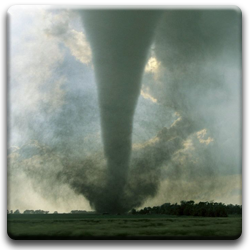Tornadoes
 Tornadoes
Tornadoes
When a tornado is coming, you have only a short amount of time to make life-or-death decisions. Advance planning and quick response are the keys to surviving a tornado.
BEFORE
- Conduct tornado drills each tornado season.
- Designate an area in the home as a shelter, and practice having everyone in the family go there in response to a tornado threat.
- Discuss with family members the difference between a “tornado watch” and a “tornado warning.”
- Contact your local emergency management office or American Red Cross chapter for more information on tornadoes.
Have disaster supplies on hand.
- Flashlight with extra batteries
- Portable, battery operated radio and extra batteries
- First aid kit and manual
- Emergency food and water
- Non electric can opener
- Essential medicines
- Cash and credit cards
- Sturdy shoes
Develop an emergency communication plan.
- In case family members are separated from one another during a tornado (a real possibility during the day when adults are at work and children are at school), have a plan for getting back together.
- Ask an out-of-state relative or friend to serve as the “family contact.” After a disaster, it’s often easier to call long distance. Make sure everyone in the family knows the name, address, and phone number of the contact person.
TORNADO WATCHES AND WARNINGS
A tornado watch is issued by the National Weather Service when tornadoes are possible in your area. Remain alert for approaching storms. This is time to remind family members where the safest places within your home are located, and listen to the radio or television for further developments. A tornado warning is issued when a tornado has been sighted or indicated by weather radar. Mobile Homes are particularly vulnerable. A mobile home can overturn very easily even if precautions have been taken to tie down the unit. When a tornado warning is issued, take shelter in a building with a strong foundation. If shelter is not available, lie in ditch or low-lying area a safe distance away from the unit.
TORNADO DANGER SIGNS
Learn these tornado danger signs:
- An approaching cloud of debris can mark the location of a tornado even if a funnel is not visible.
- Before a tornado hits, the wind may die down and the air may become very still.
- Tornadoes generally occur near the trailing edge of a thunderstorm. It is not uncommon to see clear, sunlit skies behind a tornado.
DURING A TORNADO
If at home:
- Go at once to the basement, storm cellar, or the lowest level of the building.
- If there is no basement, go to an inner hallway or a smaller inner room without windows, such as a bathroom or closet.
- Get away from the windows.
- Go to the center of the room. Stay away from corners because they tend to attract debris.
- Get under a piece of sturdy furniture such as a workbench or heavy table or desk and hold on to it.
- Use arms to protect head and neck.
- If in a mobile home, get out and find shelter elsewhere.
If at work or school:
- Go to the basement or to an inside hallway at the lowest level.
- Avoid places with wide-span roofs such as auditoriums, cafeterias, large hallways, or shopping malls.
- Get under a piece of sturdy furniture such as a workbench or heavy table or desk and hold on to it.
- Use arms to protect head and neck.
If outdoors:
- If possible, get inside a building.
- If shelter is not available or there is no time to get indoors, lie in a ditch or low-lying area or crouch near a strong building. Be aware of the potential for flooding.
- Use arms to protect head and neck.
If in a car:
- Never try to out drive a tornado in a car or truck. Tornadoes can change direction quickly and can lift up a car or truck and toss it through the air.
- Get out of the car immediately and take shelter in a nearby building.
- If there is no time to get indoors, get out of the car and lie in a ditch or low-lying area away from the vehicle. Be aware of the potential for flooding.
MITIGATION
Mitigation includes any activities that prevent an emergency, reduce the chance of an emergency happening, or lessen the damaging effects of unavoidable emergencies. Investing in preventive mitigation steps now, such as checking local building codes and ordinances about wind-resistant designs and strengthening unreinforced masonry, will help reduce the impact of tornadoes in the future. For more information on mitigation, contact your local emergency management office.
Returning Home After A Tornado
